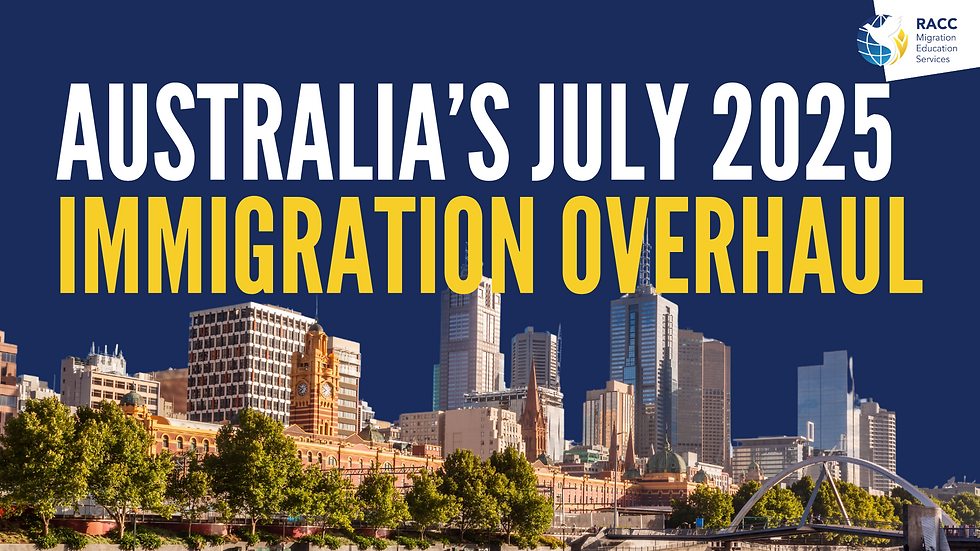Australia’s July 2025 Immigration Overhaul: Essential Updates for Skilled Workers, Students & Employers
- RACC Australia - Education and Migration Services
- Jun 27
- 4 min read

Australia’s July 2025 Immigration Overhaul introduces sweeping changes that will affect skilled visa applicants, international students, and sponsoring employers. From the launch of the new Skills in Demand visa to revised student visa costs and eligibility rules, the overhaul signals a firm shift towards streamlined migration and labour market alignment. Whether you're a graduate, a skilled worker, or an employer, these changes will directly impact your pathway in Australia.
Skills in Demand Visa: Replacing the Subclass 482
To address current labour shortages more effectively, the government has replaced the Subclass 482 with a new, more structured approach to employer-sponsored migration.
A Streamlined Approach to Sponsorship
The Subclass 482 (Temporary Skill Shortage) visa has been replaced by the Skills in Demand (SID) Visa, launching a new framework with three tailored streams:
Core Skills Pathway: For occupations on the new Core Skills Occupation List (CSOL)
Specialist Skills Pathway: For highly paid roles exceeding AUD 141,210 annually
Essential Skills Pathway: Still under development, aimed at critical sectors
Key Changes to Note:
Only 1 year of work experience is now required for sponsorship (previously 2 years)
Workers can switch employers within 180 days
Clear PR pathways to the 186 TRT visa after 2 years
Faster processing and enhanced worker mobility
New Salary Thresholds for Sponsored Workers
To maintain fairness and competitiveness in the job market, new salary benchmarks have been introduced for the Skills in Demand visa.
Income Benchmark Increases
Effective 1 July 2025:
Core Skills stream minimum salary: AUD 76,515 per year
Specialist Skills stream: AUD 141,210 per year
Employer Requirements:
Written employment contract showing minimum salary
Labour Market Salary Evidence (job ads, Fair Work data, etc.)
This ensures that sponsored workers are paid in line with local standards and prevents wage exploitation.
Core Skills Occupation List vs Existing Lists
A major shift in the occupation-based framework involves the introduction of a more dynamic and inclusive skills list tailored to Australia's workforce needs.
The Core Skills Occupation List (CSOL) replaces older occupation targeting systems for employer-sponsored migration. It currently includes 456 occupations and is reviewed regularly.
Key differences from MLTSSL, STSOL, and ROL:
Used for Skills in Demand Visa and Subclass 186 Direct Entry
Includes newly eligible occupations like:
Data Analyst
Child Care Worker
Retail Manager
Legal Secretary
Some occupations removed, e.g. Cafe/Restaurant Manager
Student Visa Changes: Fees & Financial Requirements
International students will also see significant changes that impact both application costs and financial documentation requirements.
From 1 July 2025:
Visa application fee to rise from AUD 1,600 to ~AUD 2,000+
Updated financial capacity evidence:
AUD 29,710 (living expenses)
1 year of tuition fees
AUD 2,000 (travel)
Partners: AUD 10,394
Children: AUD 4,449
These updates are intended to ensure that applicants can support themselves while studying, reducing reliance on work income.
TR 485 Temporary Graduate Visa: Major Updates
Recent changes to the Temporary Graduate Visa significantly reshape eligibility, duration, and post-study work rights.
Key Changes (Mid-2024 to Feb 2025):
Age limit reduced to 35 (except HK and UK passport holders)
Visa duration:
PhD or Master of Research: 3 years
Other graduates: 2 years
English test requirements:
IELTS: 6.5 overall (min 5.5 each band)
PTE: Overall 57, with section minimums
Visa Fee Increase:
From AUD 1,945 → AUD 2,235
For Indian Graduates (under bilateral agreement):
Bachelor’s with Honours in STEM: 3 years
Master’s or PhD: up to 4 years
Restrictions on Switching Visa Streams
To reduce visa misuse and maintain integrity in the migration system, tighter controls on onshore visa switching have been introduced.
To prevent visa hopping:
No onshore student visa applications if holding a TR 485 or Tourist visa
Genuine study intent will be more strictly assessed
Course Change Rules:
Same/higher level: Can switch without a new visa
Lower level or to ELICOS: Requires a new visa
These rules ensure that Australia’s student visa program supports long-term skill-building, not short-term stay extensions.
Caps and School Regulations for International Students
Alongside individual visa changes, broader policies are being introduced to better regulate education providers and control overall student intake.
Proposed Student Intake Cap:
A national planning level of 270,000 new international enrolments (not yet confirmed)
School Requirements:
Must be CRICOS-registered
Comply with ESOS Act and National Code
Provide quality education, infrastructure, and graduate outcomes
These measures aim to support only high-performing institutions and improve student experiences.
Work Rights for Postgraduate Students
Clarifications on work entitlements aim to reduce confusion and align policies with student qualification levels. Currently, only Master’s by Research and PhD students enjoy unrestricted work rights.
Students in other courses (Bachelor’s, Diploma, Coursework Masters) are capped at 48 hours/fortnight during study periods. No new changes have been formally introduced yet.
Navigating Australia’s July 2025 Immigration Overhaul: Plan Your Next Step
Australia's July 2025 Immigration Overhaul presents opportunities for those who understand and act on the changes. Whether you're applying for a skilled visa, planning to study, or sponsoring overseas talent, it's crucial to align with the new requirements to avoid delays and rejection.
Book a free consultation with RACC Migration and Education Services today to receive expert advice on how to navigate the new system and make informed decisions about your future in Australia.







Comments